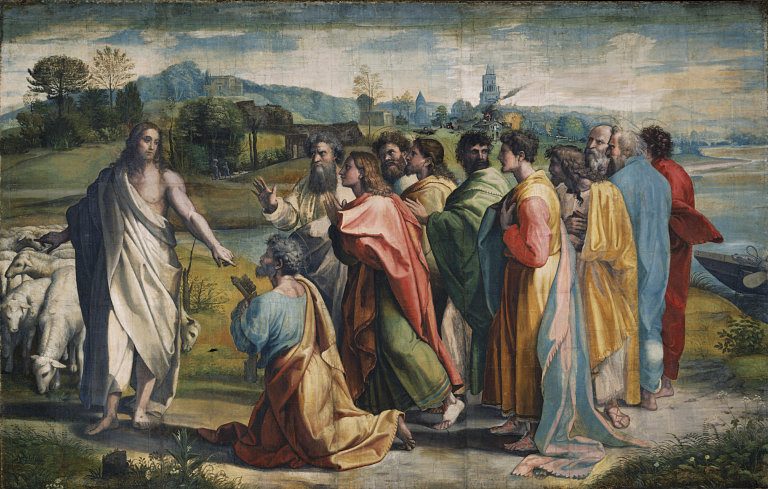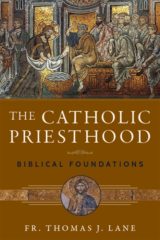By Fr. Thomas J. Lane
Fr. Thomas J. Lane is a priest of the Diocese of Cloyne (Ireland) and is Assistant Professor of Sacred Scripture at Mount St. Mary’s Seminary, Emmitsburg, Maryland. He is the author of The Catholic Priesthood: Biblical Foundations.

While the primacy of Peter is affirmed by the New Testament, the Petrine succession cannot be directly deduced from any passage of the New Testament, although from the beginning the bishops of Rome were recorded as successors. Nonetheless, we can infer Petrine succession in Scripture.
Eliakim succeeded Shebna as master of the king’s house in Isaiah 22. That office of master of the king’s house was not just for Eliakim. The office existed prior to Shebna and continued after Eliakim. Apart from Shebna, the names of three of his predecessors are recorded in Scripture: Ahishar in 1 Kings 4:6 during the reign of Solomon, Arza in 1 Kings 16:9 during the reign of Asa, and Jotham in 2 Kings 15:5 during the reign of his father, Azariah (also known as Uzziah in many biblical books). Scripture mentions two of the corresponding officials in the courts of the northern kings: Obadiah during the reign of Ahab in 1 Kings 18:3, and an unnamed official in 2 Kings 10:5. When bestowing the primacy on Peter, Christ’s deliberate paralleling of the language of Isaiah 22:22 for the appointment of Eliakim as vizier in succession to Shebna could be taken to indicate Christ’s intention that Peter be succeeded by another who would have primacy (the keys) and by another after him and so on, since Eliakim himself would be succeeded by another vizier.
We can offer other suggestions that Christ intended Peter would have successors in his ministry of primacy, and the concept of succession was certainly well known at the time of Jesus, because the scribes and Pharisees regarded themselves as successors to Moses’ teaching authority (Matt 23:2; see John 9:28). Peter is the rock, and the rock will remain, while the Church will grow and spread during the ensuing decades and centuries. A rock is not an image of temporality but of permanence and endurance. Immediately after telling Peter that he is the rock, Christ proclaimed that the gates of death would not prevail against the Church (16:18). Even if individual Church members will be martyred, the Church itself will not die.
This promise suggests a long time span, and coming immediately after the declaration of Peter as the rock, adds more weight to the suggestion that Peter as rock is an image of permanence including successors. In Isaiah 51:1–2, Abraham is described as the rock from which the Jews came. Abraham, the father of the Jewish people, received promises of many descendants and land from God (Gen 15:5; 17:8), and those promises held good for the patriarch after him, his son Isaac (Gen 26:3–4), and for the patriarch after him, his son Jacob (Gen 28:13–14). In a similar way, I would suggest Christ’s promise of primacy to Peter was not only for Peter but also for those who would succeed him. Christ’s charge of primacy surely makes most sense when seen as a promise for not just Peter but also for his successors. The duty and responsibility bestowed on Peter was one that could not die with Peter’s martyrdom, but continued on the shoulder of his successors, as the Church is ever in need of unity and governance. It seems only logical that when Christ established Peter’s primacy, it was needed to stabilize the Church, not just in the first years after Christ but also during subsequent centuries.
Peter was to serve his brothers by being a bond of unity in the Church. This important duty is evident in the most beautiful title given to Peter’s successor, “Our Holy Father.” The father is the one who unites the family, and “Our Holy Father,” the successor of Peter, unites the whole Church. The role of Peter’s successor as servant of the servants of God is to constantly forge unity in the Church. Christ, in his foresight, saw the Church’s need for a unifier, and so Ratzinger states, “The Roman primacy is not an invention of the popes, but an essential element of ecclesial unity that goes back to the Lord and was developed faithfully in the nascent Church.” Of course, no man who is given the responsibility of succeeding Peter can, by his own human strength, fulfill the task, and history reveals the weaknesses of the men so entrusted. But above all, the Roman primacy reminds us of God’s guidance and presence with his Church.
You Might Also Like

During the time of Jesus Christ, neither he nor his apostles would have had the term “priest” applied to their mission or identity. The priesthood was exclusive to the tribe of Levi and at that time was associated primarily with their sacrificial liturgies in the temple. But with Christ’s death on the Cross, a new understanding of Christ as priest began to grow in light of his priestly self-sacrifice. The Catholic Priesthood: Biblical Foundations by Fr. Thomas Lane highlights the Scriptural evidence indicating that Christ’s intention was to establish a New Covenant priesthood that he would share with his apostles and their successors.